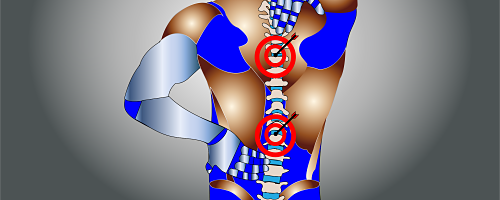Eight million people in the UK suffer with back pain – are you one of them?
Millions of people in the UK suffer with back pain according to The British Pain Society with eight million adults in the UK reporting chronic back pain that is moderate to severely disabling.
Back pain alone accounts for 40% of sickness absence in the NHS and overall costs the UK economy £10 billion.
Back problems can occur in all professions from sedentary office workers, those in manual trades to company car drivers who spend a large part of the day sat behind the wheel.
Employers’ responsibility
Since the start of the pandemic the number of people working from home has increased dramatically. However, employers still have a duty of care to provide a safe and practical place to work.
Many employees are working in unsuitable positions whilst at home and working from the kitchen table or bending over a laptop for hours can lead to a wide range of back problems.
Harley Street osteopath, Oliver Eaton says laptops were primarily designed for portability, with very little thought going in to how posture-friendly they are. The combination of the screen being lower than the level of your eyes, and the fact that you have to reach over the trackpad to use the keyboard, causes your posture to stoop over time. If you are in that position for up to eight hours a day, then this can often lead to back pain.
Eaton says there are ways to prevent back pain if working on a laptop. He said, “Buying a laptop stand helps to bring your screen up to eye level. Also, buying a separate Bluetooth keyboard and mouse ensures that you aren’t having to stoop over, and you can position yourself in a similar ergonomic set-up to what you have at work.”
According to the Health and Safety Executive employers should have measures in place to prevent employees from sustaining back injuries. It states:
- Avoid work activities that can cause back pain, where reasonably practicable
- Where the activity cannot be avoided, assess it to see what you can do to reduce the risk of back pain
- Apply the control measures you have identified and monitor and review them to make sure they are working
- Consult your workers and, if they have health and safety concerns, do something about them
The safety body also outlines several measures employers can take to reduce the likelihood of an employee sustaining a back injury. It recommends employers:
- Identify what activities can cause back pain and decide whether they can be avoided or changed
- Ask your workers for input – they have first-hand knowledge of the work and can suggest changes
- Think about how you can make jobs physically easier, for example, by moving loads on wheels
- Make sure controls, for example lifting aids, are available, used and maintained
- Look for signs of back pain among your workers, such as a reluctance to do a particular task, which may suggest your controls are not working
- Encourage them to report problems early to you or their worker representative so they get the right help
Lower back pain
The most common form of back pain reported is lower back pain or lumbago. The National Institute for Health and Clinical Excellence (NICE) and the National Clinical Guideline Centre have published guidance to improve the early management of persistent non-specific low back pain. This covers people who have been in pain longer than six weeks but less than one year, where the pain may be linked to structures in the back such as the joints, muscles and ligaments.
The guidance suggests that health professionals should advise patients with lower back pain to follow recommendations. These include:
- Advise people with low back pain that staying physically active as much as possible is likely to help, provide people with advice and information to help them manage their low back pain
- Offer one of the following treatment options, considering the patient’s preference: an exercise programme, a course of manual therapy including manipulation, or a course of acupuncture (more details on each below). Consider offering another of these options if the chosen treatment does not result in satisfactory improvement
- Consider offering a structured exercise programme tailored to the individual that may include exercises to strengthen muscles, improve posture and stretching
- Consider offering a course of manual therapy, including spinal manipulation, spinal mobilisation and massage. Treatment may be provided by a range of health professionals including chiropractors, osteopaths, manipulative physiotherapists or doctors who have had specialist training
- Consider offering a course of acupuncture needling, up to a maximum of 10 sessions over a period of up to 12 weeks
- Injections of therapeutic substances into the back for non-specific low back pain are not recommended
- Offer a combined intensive exercise and psychological treatment programme for people who have had at least one less intensive treatment already, but who still have disabling pain which causes significant distress or seriously impacts on daily life
- Do not offer X-ray of the lumbar spine for the management of non-specific low back pain, and only offer an MRI scan within the context of a referral for an opinion on spinal fusion
Sometimes back pain can be caused by a medical condition such as a slipped (prolapsed) disc – where a disc of cartilage in the spine presses on a nerve or Sciatica which is the irritation of the nerve that runs from the pelvis to the feet.
These conditions tend to cause additional symptoms, such as numbness, weakness or a tingling sensation, and should be treated differently from non-specific back pain.
According to the NHS, you should contact a GP or NHS 111 immediately if you have back pain and:
- numbness or tingling around your genitals or buttocks
- difficulty urinating
- loss of bladder or bowel control
- chest pain
- a high temperature
- unintentional weight loss
- a swelling or a deformity in your back
- it does not improve after resting or is worse at night
- it started after a serious accident, such as after a car accident
- the pain is so bad you are having problems sleeping
- pain is made worse when sneezing, coughing or going to the toilet
- the pain is coming from the top of your back, between your shoulders, rather than your lower back
These problems could be a sign of something more serious and need to be checked urgently.
Compensation
If you believe that your back issues were caused by something related to your regular place of work or an accident you have been involved in, you could be due compensation.
You have three years from the date of your injury to claim and if injured at work your employer is required by law to have employers’ liability insurance in place to cover such claims.
The amount of compensation will depend on the severity of your back injury. Minor injuries where a full recovery is made within three months could pay out up to £2,300 whereas a severe injury with damage to the spinal cord resulting in disability could pay out up to £151,000.
For more information on claiming compensation and the amount you could be entitled to, contact NV Legal:
Telephone: 03330 112732
Email: info@nvlegal.co.uk
Social: Facebook Twitter LinkedIn
Website: www.nvlegal.co.uk
USEFUL LINKS:
https://www.nhs.uk/conditions/back-pain/
https://www.hse.gov.uk/msd/backpain/


